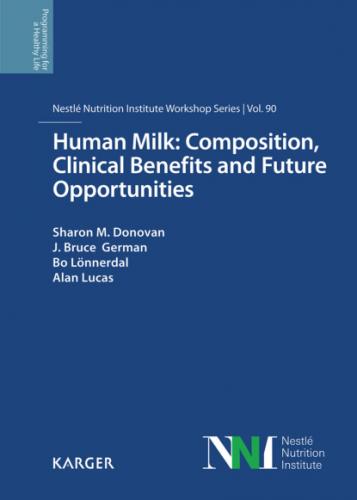Human Milk: Composition, Clinical Benefits and Future Opportunities. Группа авторов
P, Ding J, McDonald D, Fewtrell MS: Real-time 3D ultrasound imaging of infant tongue movements during breast-feeding. Early Hum Dev 2013; 89: 635–641.
9Woolridge MW: The mechanics of breastfeeding revised: new insights into how babies feed provided by fresh ultrasound studies. 5th Europaediatr Congr, Vienna, June 2012.
10Woolridge MW: The mechanics of breastfeeding: does the baby suck or suckle? Findings from 2D ultrasound studies. 20th Annu Int Meet Acad Breastfeed Med, Los Angeles, October 2015.
11Geddes DT, Kent JC, Mitoulas LR, Hartmann PE: Tongue movement and intra-oral vacuum in breastfeeding infants. Early Hum Dev 2008; 84: 471–477.
12Geddes DT, Sakalidis VS, Hepworth AR, et al: Tongue movement and intra-oral vacuum of term infants during breastfeeding and feeding from an experimental teat that released milk under vacuum only. Early Hum Dev 2012; 88: 443–449.
13Sakalidis VS, Williams TM, Garbin CP, et al: Ultrasound imaging of infant sucking dynamics during the establishment of lactation. J Hum Lact 2013; 29: 205–213.
14Sakalidis VS, Hepworth AR, Hartmann PE, Geddes D: Ultrasound imaging of infant sucking dynamics during the establishment of lactation. J Hum Lact 2013; 29: 205–213.
15Ardran GM, Kemp FH: A correlation between suckling pressures and the movements of the tongue. Acta Paediatr 1959; 48: 261–272.
16Thexton A, Crompton A, Owerkowicz T, German R: Correlation between intraoral pressures and tongue movements in the suckling pig. Arch Oral Biol 2004; 49: 567–575.
17Grassi A, Cecchi F, Sgherri G, et al: Sensorized pacifier to evaluate non-nutritive sucking in newborns. Med Eng Phys 2016; 38: 398–402.
18Unsworth A, Dowson D, Wright V: Cracking joints. A bioengineering study of cavitation in the metacarpophalangeal joint. Ann Rheum Dis 1971; 30: 348–358.
19Zoppou C, Barry SI, Mercer GN: Dynamics of human milk extraction: a comparative study of breast feeding and breast pumping. Bull Math Biol 1997; 59: 953–973.
20Elad D, Kozlovsky P, Blum O, et al: Biomechanics of milk extraction during breast-feeding. Proc Natl Acad Sci USA 2014; 111: 5230–5235.
21Mortazavi SN, Geddes D, Hassanipour F: Lactation in the human breast from a fluid dynamics point of view. J Biomech Eng 2017; 139: 011009.
22Monaci G, Woolridge MW: Ultrasound video analysis for understanding infant breastfeeding. Proc 18th IEEE Int Conf Image Process (ICIP), September 2011. DOI: 10.1109/ICIP.2011.6115802.
23Prieto CR, Cardenas H, Salvatierra AM, et al: Sucking pressure and its relationship to milk transfer during breastfeeding in humans. J Reprod Fertil 1996; 108: 69–74.
24Drewett RF, Woolridge MW: Milk taken by human babies from the first and second breast. Physiol Behav 1981; 26: 327–329.
25How TV, Ashmore MP, Rolfe P, et al: A Doppler ultrasound technique for measuring human milk flow. J Med Eng Technol 1979: 3:66–71.
26Woolridge MW, How TV, Drewett RF, et al: A method for the continuous measurement of milk intake at a feed in breast-fed babies. Early Hum Dev 1982; 6: 365–373.
27Chalmers I, Enkin M, Keirse JMC: Effective Care in Pregnancy and Childbirth. Oxford, Oxford University Press, 1989.
28Renfrew MJ, Woolridge MW, Ross McGill H: Enabling Women to Breastfeed: A Review of Practices Which Promote or Inhibit Breastfeeding – With Evidence-Based Guidance for Practice. London, The Stationery Office, 2000.
1 Some caution is needed when generalizing from these data as they are based on a preliminary screening of ultrasound recordings; while some sections of feeding were not able to be analyzed, because of movement artefact, we regard them as substantively correct.
State of Breastfeeding in the World
Donovan SM, German JB, Lönnerdal B, Lucas A (eds): Human Milk: Composition, Clinical Benefits and Future Opportunities. Nestlé Nutr Inst Workshop Ser, vol 90, pp 33–34, (DOI: 10.1159/000490483)
Nestlé Nutrition Institute, Switzerland/S. Karger AG., Basel, © 2019
______________________
Summary on State of Breastfeeding in the World
Alan Lucas took an overview of the scientific evidence that supports breastfeeding. He identified that three key pillars of breastfeeding science were underpinned by flawed science and thinking. That breastfeeding has evolved over millions of years of mammalian evolution, spawned the view human breast milk must be the perfect diet for human infants. But this view does not take into account the competing needs of mother and offspring, nor the current mismatch between our ancient genes and modern environment (evolutionary discordance) which may result in disease. He noted that 1,500 papers on the composition breast milk were too flawed to derive realistic values for the dietary intake of breastfed babies. The use of such data by formula manufactures resulted in overfeeding of babies contributing to the epidemic of obesity and cardiovascular disease risk in later life. And he noted that the numerous proposed beneficial outcomes of breastfeeding were mostly based on potentially confounded observational studies. He addressed these issues by showing that more modern research and understanding was resolving the flaws of past work and thinking. This newer work puts breastfeeding medicine on a sounder scientific footing – and this is in the interests of improving the care of infants and the health outcomes of populations.
Mike Woolridge delved deeply into the mechanical aspects of suckling. He noted two long-standing principles about the way babies removed milk from the breast – one mechanism is suction, and the other, the wave-like movements of the tongue that exert pressure on the undersurface of the nipple and breast in the oral cavity. These aspects were confirmed by imaging studies from the 1950s and underpinned successful “best practice” in breastfeeding management. He explained however that more recently the process of suckling has been revisited with more sophisticated imaging techniques and the application of engineering approaches to build new mathematically complex models to explain how breastfeeding works. He critically appraised the strengths and weaknesses of the new research but gratifyingly concluded that a new consensus on the principles of suckling, whilst extending our understanding, does not in any way undermine or change well-tried and effective best practices for the management of breastfeeding – indeed more strongly reaffirms them. Such practices impact on the success
